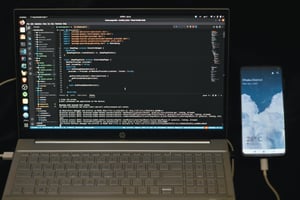If your Node.js app has ever crashed in production, you know how stressful it can be to figure out...
The Ulitmate Guide To Node JS Performance Monitoring (Techniques & Tools)
If your Node.js application is sluggish, you can lose users and revenue. More often than not, performance issues arise from the backend. So, if you're dealing with a slow Node.js app, it's essential to investigate what's happening on the server. Node.js performance monitoring tools can help you quickly identify issues in your app's performance before they affect your user experience. Next, we'll look at how you can use Nodejs logging to monitor performance.
Table of Contents
- What Is Node JS Performance Monitoring?
- Why Is Node JS Performance Monitoring Important
- What Metrics Should Be Monitored?
- How Can You Best Monitor Node JS Application Performance? 3 Best Practices
- 9 Best Tools For Node JS Performance Monitoring
- 3 Challenges Of Node JS Performance Monitoring & How To Overcome Them
- Catch Issues Before They Affect Your Users with Alerty's NodeJS Logging Tool
What Is Node JS Performance Monitoring?
-jpg.jpeg?width=2400&height=1600&name=rivage-Fa9b57hffnM-unsplash%20(1)-jpg.jpeg)
Node.js performance monitoring is about monitoring the performance of your Node.js application. It involves gathering data on various aspects of your app's performance to ensure it operates smoothly and meets your expected service standards. At its core, Node.js performance monitoring includes tracking the availability of your:
- Applications
- Monitoring logs
- Measuring key metrics
These activities help you spot potential issues before they become significant problems. For instance, if your app is starting to slow down or if there’s an unusual spike in memory usage, performance monitoring tools can alert you so you can address the issue quickly.
Visual Mapping
One critical aspect of performance monitoring is its ability to provide graphical or topographical visibility into your application's architecture. This means you get a clear, visual understanding of how different parts of your application perform and interact. It’s like having a map of your app's internals, helping you pinpoint exactly where things might go wrong.
Common issues that can affect the performance of a Node.js application include:
- High latency (slow response times)
- Memory leaks
- Recurring bugs
- Server downtime
Automated Insights
Monitoring tools have evolved from basic manual checks to advanced automated systems that provide real-time insights. These tools monitor performance and help identify the root causes of problems, offering a detailed, intelligence-based view of how every component in your Node.js architecture is behaving.
Why Is Node JS Performance Monitoring Important
-jpg.jpeg?width=2400&height=1600&name=mohammad-rahmani-W-LQbAUhE64-unsplash%20(2)-jpg.jpeg)
Node.js application performance monitoring is essential because it goes beyond just building an app; it's about ensuring it continues running smoothly and efficiently over time. As a developer, your job continues once the app is deployed. Monitoring the app's performance is critical to consistently:
- Meeting user expectations
- Delivering the desired experience
Key Performance Metrics
Performance monitoring allows you to gather crucial data about how your Node.js application is functioning. You can quickly identify any issues that might affect the app's performance by measuring various metrics, such as:
- Response times
- Memory usage
- Error rates
This process helps you catch problems before they escalate, ensuring your app remains reliable and responsive.
Global Visibility
Another key benefit of Node.js performance monitoring is gaining geographical and topological visibility into your application's architecture. This means you can see how different parts of your app interact and perform across various locations and environments.
Such visibility is crucial for detecting and resolving issues that might not be immediately apparent, ensuring that your app performs well for users, no matter where they are.
Business Continuity
Node.js performance monitoring is critical because it helps maintain the health and efficiency of your application. By continuously monitoring and improving your app's performance, you can:
- Deliver a seamless user experience
- Prevent downtime
- Ensure your Node.js application remains a robust and reliable tool for your business or project
Secure Your App with Alerty Today
Alerty is a cloud monitoring service for developers and early-stage startups. It offers application performance monitoring, database monitoring, and incident management. It supports technologies like NextJS, React, Vue, and Node.js, helping developers identify and fix issues.
Catch issues before they affect your users with Alerty's NodeJS logging tool today!
Related Reading
What Metrics Should Be Monitored?

CPU Utilization: Are Your Node JS Applications Overheating?
CPU utilization shows the percentage of CPU resources that your Node.js application is using. If you notice sustained high CPU utilization, it could signal your app is struggling with heavy computations or inefficient code, leading to performance bottlenecks. Monitoring this helps identify when your application might need optimization or scaling.
Memory Usage: No One Wants to Deal with a Node JS Application Memory Leak
Monitoring memory usage is crucial because it tracks how much your Node.js application consumes. Memory leaks, where the app consumes more memory over time without releasing it, can lead to slowdowns or even crashes.
Keeping an eye on memory usage helps spot these issues early, allowing you to address them before they impact your users.
Response Time: A Key Node JS Performance Metric for User Experience
This metric measures the time it takes for your Node.js application to respond to a request. High response times can lead to a poor user experience, as users may experience delays when interacting with your app. By monitoring response times, you can ensure your app remains responsive and identify any slowdowns that need fixing.
Database Queries Per Second (QPS): How Many Queries Can Your Node JS Application Handle?
QPS measures the number of database queries your Node.js application executes per second. High QPS can overload your database server, leading to slower performance or even crashes. Monitoring this metric helps you manage database load effectively, ensuring your app can handle queries without bogging down the system.
Error Rate: How Many Requests to Your Node JS Application Are Failing?
The error rate is the percentage of requests that result in errors. A high error rate indicates instability or other issues in your application that need attention. By tracking this metric, you can quickly identify and resolve problems before they affect too many users, maintaining your app's reliability.
How Can You Best Monitor Node JS Application Performance? 3 Best Practices
-jpg.jpeg?width=2400&height=1600&name=mapbox-HC52Y3zuznE-unsplash%20(1)-jpg.jpeg)
Identify and Monitor Key Metrics
The first step in effective Node.js performance monitoring is understanding what metrics are crucial to track. This includes key metrics like:
- Latency
- Error rates
- Throughput
- Service performance
Targeted Logging
It doesn't stop there—you must also identify the right logs and critical events to monitor. By knowing what to focus on, you can gather the necessary data to accurately assess your application's health and performance.
This targeted approach ensures you can handle irrelevant information and quickly pinpoint areas needing attention.
Set Up Dynamic Alerts
Alerts are a vital part of any monitoring system, but their effectiveness depends on how well they’re configured. It's essential to set up dynamic alerts and prioritize events based on their potential impact on your application.
High-priority alerts should trigger immediate action related to issues that could severely affect performance or availability. On the other hand, low-priority alerts can be monitored and addressed later. Properly configuring alerts helps you catch and resolve critical issues before they escalate, ensuring your application remains stable and responsive.
Direct Alerts to the Right Team Members
Once your alerts are set up, they must reach the right people on your team. Each alert should be directed to the team members whose expertise is relevant to the issue. For example, an alert about a database query problem should go to the administrator, while a server-related alert might go to the IT or operations team.
This targeted approach ensures that problems are addressed promptly by those best equipped to handle them, reducing downtime and improving overall application performance.
9 Best Tools For Node JS Performance Monitoring
-jpg.jpeg?width=2400&height=1600&name=charlesdeluvio-pjAH2Ax4uWk-unsplash%20(1)-jpg.jpeg)
1. Alerty
Alerty is a cloud monitoring service for developers and early-stage startups, offering:
- Application performance monitoring
- Database monitoring
- Incident management
It supports technologies like:
- NextJS
- React
- Vue
- Node.js, helping developers identify and fix issues
Database and API Monitoring
Alerty monitors databases such as:
- Supabase
- PostgreSQL
- RDS
Tracking key metrics like CPU usage and memory consumption, it features quick incident management and Real User Monitoring (RUM) to optimize user experience. Its universal service monitoring covers dependencies like:
- Stripe API
- OpenAI
- Vercel
AI-Driven Affordability
Alerty uses AI to simplify setup, providing a cost-effective solution compared to competitors. It is designed for ease of use, allowing quick setup, and integrates with tools like Sentry, making it ideal for developers and small teams needing efficient, affordable monitoring.
Catch issues before they affect your users with Alerty's NodeJS logging solution today!
2. New Relic
New Relic stands out with its comprehensive monitoring capabilities tailored for Node.js applications. It offers real-time performance monitoring, allowing you to track key metrics such as:
- Response times
- Error rates
- Throughput
This helps you understand how your application performs at any given moment. Additionally, New Relic provides error analytics that pinpoint problematic lines of code, enabling rapid issue resolution. The service maps feature visualizes your application’s architecture, which is instrumental in identifying bottlenecks and understanding dependencies.
3. Dynatrace
Dynatrace delivers end-to-end observability with a focus on intelligent automation. Its anomaly detection uses AI to spot performance irregularities and provide insights into your application's overall health. This proactive approach helps address potential issues before they escalate.
Dynatrace also allows you to create custom dashboards for tailored visibility of your metrics and tracks critical business processes to optimize performance based on real user interactions.
4. PM2
PM2 is renowned as a process manager but has robust monitoring capabilities. It ensures your application processes are consistently managed and automatically restarted if necessary. PM2 provides real-time CPU and memory usage metrics and detailed application logs, offering a comprehensive view of your application’s operational health.
5. Raygun
Raygun focuses on real-time performance monitoring and error tracking, making it ideal for quickly:
- Identifying
- Addressing issues
Crash and Performance Analysis
Its crash reporting feature provides valuable insights into the following:
- Application crashes
- Performance problems
Raygun monitors user experiences, helping you understand how users interact with your application and where improvements can be made.
6. Better Stack
Better Stack combines logging and uptime monitoring into a unified solution. It offers incident management by alerting your team about any irregularities in application behavior, ensuring timely responses to potential issues.
Better Stack’s log management centralizes log data, making troubleshooting and analyzing application performance easier.
7. Clinic.js
Clinic.js is a suite of tools specifically designed to diagnose performance issues in Node.js applications. It excels in performance profiling, helping you identify and address bottlenecks.
Clinic.js also visualizes performance data, making complex information more accessible and easier to analyze.
8. Datadog
Datadog offers a comprehensive application performance monitoring (APM) solution that supports Node.js. It provides end-to-end distributed tracing, which monitors your application across various services and correlates frontend and backend data.
This holistic view provides a complete picture of your application’s performance. Datadog also tracks the health of service dependencies, which is crucial for maintaining overall system performance.
9. Prometheus and Grafana
Prometheus and Grafana form a powerful open-source combination for monitoring and visualization. Prometheus collects detailed metrics from your Node.js applications, providing a deep understanding of performance.
Grafana complements this by allowing you to create custom dashboards to visualize and analyze the collected data, offering a flexible approach to monitoring your application's health.
Related Reading
- Node Js Security
- NodeJS Profiling
- NodeJS Metrics
- Node Js Performance Testing
- NodeJS Server Monitoring
3 Challenges Of Node JS Performance Monitoring & How To Overcome Them

Node.js, like any other technology, comes with its challenges. Research and experience can overcome some obstacles, while others require the right tools and practices. Let's look at three challenges to help your team maintain peak Node.js performance.
1. Lack of Documentation
Node.js is a fantastic tool, especially with its expansive ecosystem of packages and modules through NPM. One of the challenges developers often face is the need for comprehensive, centralized documentation. NPM has excellent documentation, but it’s not always extensive enough to cover every specific use case or problem you might run into.
This can leave your team scrambling for answers or making educated guesses regarding implementation.
How to Overcome This
To sidestep this issue, ensuring that your team creates and maintains thorough internal documentation is crucial. Before diving deep into development, set aside time to draft clear documentation that covers your project’s specific needs.
Encourage your team to document their code as they go, especially for custom solutions or less straightforward implementations. This proactive approach saves time and frustration down the road.
2. Code Debt
When deadlines loom, and rapid development becomes the focus, it’s easy to fall into the trap of prioritizing speed over quality. This often results in code debt—where shortcuts are taken, or best practices are ignored to quickly get features out the door. The problem with code debt is that it accumulates and can lead to significant issues later, including:
- Poor performance
- Bugs,
- Higher maintenance burden
How to Overcome This
The key to avoiding code debt is balance. While it’s essential to move quickly, don’t sacrifice code quality. Implement regular code reviews, enforce coding standards, and invest in automated testing to ensure quality remains a priority.
If code debt does start to build up, schedule time for refactoring and optimization before it becomes unmanageable.
3. Irregular App Performance Monitoring
Performance monitoring is essential for any application, but it can easily be overlooked, especially when things seem to be running smoothly. Irregular or inconsistent tracking can lead to gaps in data, making it harder to understand:
- User behavior
- Spot bugs
- Optimize performance
Without continuous monitoring, you might miss out on crucial insights that could help improve your application’s:
- Reliability
- User experience
How to Overcome This
To tackle this, make performance monitoring a routine part of your development process. Use monitoring tools designed for Node.js, such as New Relic, Datadog, or Prometheus, to constantly monitor your application’s performance. Set up alerts for potential issues like memory leaks or slow response times so you can address problems before they escalate.
Regularly review the data you collect to fine-tune your application and ensure it’s meeting performance expectations.
Catch Issues Before They Affect Your Users with Alerty's NodeJS Logging Tool
Node JS is a popular runtime for building fast, highly scalable applications. But what happens when your Node JS app encounters an error or performance issue? You will know what went wrong or how to fix it with a proper logging strategy.
Logging can help you track down issues in your application and understand what's happening in your code when errors occur. In short, logging is vital for maintaining and monitoring the health of your Node JS application.







